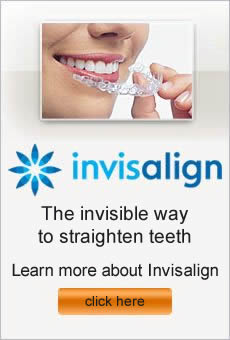When you have space between your teeth, also called diastema, you should consult an orthodontist about the best way to deal with this issue. Though these spaces can occur between any two teeth, they most frequently appear between the two front teeth. A diastema can be caused by a variety of factors such as:
Missing or undersized teeth
When certain teeth don’t develop or if the permanent teeth are small, a space can occur. This situation frequently happens with the upper lateral incisors, the teeth next to the two upper front teeth.
An oversized labial frenum
The piece of tissue that usually stretches from the inside of your upper lip to the gum just above your two upper front teeth, the labial frenum may sometimes grow past the two front teeth. In this case, the tissue blocks the natural closure of the teeth.
Certain habits
Thumb sucking and pacifier use can create additional space, especially between front teeth.
Periodontal disease
When gum disease progresses, the results is loss of the bone that supports the teeth, which can make teeth loose and create space.
Temporary gaps from tooth loss
As primary teeth fall out and permanent teeth erupt, young children may develop a diastema. These spaces typically close once adult teeth move into their permanent position.
If you have a diastema, your orthodontist can perform a complete evaluation. After determining the cause of the space, the doctor can devise a treatment plan to close the gap and correct any alignment issues. Once the space is corrected, you should achieve a flawless smile.
We create beautiful smiles at our orthodontic dental practice in Sherman Oaks, CA – Mehdi Fotovat, DDS
Orthodontics is the branch of dentistry concerned with prevention and correction involving irregularities of the teeth. In addition to completing dental school, orthodontists must all take an additional two to three years of specialized training. Often, general dentists will refer their patients to the orthodontist if they are concerned about malocclusion, or a bad bite.
Not only are crooked or crowded teeth not very attractive, but they can also contribute to oral health problems. Because routine home care, such as brushing and flossing, is more difficult with crowded teeth, you may be at an increased risk for issues like tooth decay and gum disease. Misalignment can also lead to added stress on the chewing muscles, causing headaches, TMJ dysfunction, or neck, shoulder, and back pain. By adjusting how teeth fit together and how your jaws line up, an orthodontist can straighten teeth and correct your bite.
The only way to determine if you need orthodontic treatment is to visit an orthodontist. During an evaluation appointment, the doctor will take a full medical and dental health history, conduct an oral exam, make impressions of your teeth, and take special X-rays and photographs. With this information, your orthodontist will be able to identify the necessary treatment and complete a comprehensive plan for creating your new, improved smile.
Orthodontic treatment can utilize various appliances and therapies to shift teeth, retrain muscles, and affect jaw growth. Most people think of braces when they hear the word orthodontics, but treatment may also involve head gear, fixed spacers, splints, and palatal expanders. The severity of the issue will determine which methods your orthodontist recommends.
Come in for an evaluation at our orthodontic dental practice in Sherman Oaks, CA – Mehdi Fotovat, DDS
If you child is one of the estimated four million children in the United States and Canada undergoing orthodontic treatment, you probably want to know more about orthodontics and why you need to be concerned about this type of dental therapy. It’s also good to understand the purpose of orthodontics in case you or a loved one need treatment in the future. The following questions and answers will offer you valuable information about orthodontic treatment.
Why does orthodontic treatment really matter?
Not only will a gorgeous smile and properly aligned bite make your child feel more confident, but it can also improve dental health. Straight teeth are easier to clean, which reduces the risk for cavities and gum disease.
How will I know if my child needs treatment?
The American Association of Orthodontists (AAO) encourages parents to have their children evaluated by an orthodontist at around age seven. At this point, children have enough permanent teeth for the orthodontist to evaluate how well the teeth and jaws meet, and to identify current or developing issues.
Does my child’s growth impact treatment?
Often, growth and orthodontic therapy work hand-in-hand. In many cases, the orthodontist can capitalize on your child’s growth to move jaws and teeth into their ideal positions.
What is the best way to find an orthodontist?
Various resources exist to help you choose the right orthodontist. Ask friends and family, talk with your child’s dentist, and use the Internet. Once you identify several candidates, schedule consultation appointments so that you can get a feel for the doctor and staff.
Schedule a consult at our orthodontic dental practice in Sherman Oaks, CA – Mehdi Fotovat, DDS
First introduced in 1999, Invisalign offers adult patients the chance to enjoy perfect smiles without the discomfort or embarrassment of traditional metal braces. Using a series of clear, custom aligners, the Invisalign system applies gentle pressure to move teeth into the proper position. Often, Invisalign takes only 12 to 18 months, a shorter time frame than regular orthodontic treatment.
Invisalign was originally created for adults that had no ongoing jaw development and all their permanent teeth. Recently, the company has produced Invisalign Teen, designed to address the special needs of younger patients. With Invisalign Teen, non-adult patients can enjoy the flexibility and ease of the clear aligners.
Certain features are specific to Invisalign Teen. For instance, this product has specially engineered eruption tabs, which compensate for erupting second molars. As well, the design incorporates power ridges to help with certain difficult tooth movements, and compliance indicators provide a visual cue of patient wear, allowing orthodontists and parents to monitor their teens.
Points to consider about Invisalign Teen:
• For best results, your teen should wear the aligners 20 to 22 hours a day, taking them out only to eat and brush.
• Your teen will wear each set of aligners for about two weeks and then move on to the next group in the series.
• With Invisalign Teen, there is little maintenance. Your teen will visit the orthodontist approximately every six weeks to monitor progress and to receive the next sets of aligners.
• Oral hygiene is easier with Invisalign Teen because the aligners can be removed for brushing and flossing. Patients also won’t have to deal with broken brackets or lose wires.
HappInvisalign for Teens at Mehdi Fotovat DDS in Valley Village CA
An estimated four million people in the U.S. each year undergo orthodontic treatment. If one of those patients is your teenager, you are probably faced with the daunting task of making sure they take care of their teeth and braces. While kids and teens normally love bright, shiny things, that concept probably doesn’t hold true for their orthodontia. Follow these tips to help your teen have a successful experience while wearing their braces.
Encourage lots of brushing
Individuals without braces are supposed to brush twice a day, so double that number if you are an orthodontic patient. Remembering to brush may not make your teen’s priority list, so offer gentle reminders throughout the day.
Send a travel toothbrush
Because your teen likely spends hours away from home, you should purchase a toothbrush and toothpaste for on the go. Your son or daughter will have a harder time fighting you on this point if you supply the right tools.
Focus on getting between teeth
Though it may be more difficult, your teen needs to floss once a day and focus on reaching between teeth, at the gum lines, and around brackets. Flossing is the best way to combat plaque accumulation.
Schedule professional cleanings
When your teen has braces, regular cleanings are critical. Because they have a harder time getting all the areas spick and span, you should make sure to visit the dentist’s office. The hygienist will be able to remove tartar and any build up on teeth.
Recruit help
Sometimes, teenagers respond better when the information doesn’t come from their parents. Ask your orthodontist and dentist to explain the importance of good hygiene to your child.
Caring for your child’s teeth – Dr. Fotovat – Burbank Orthodontist – WebBraces.com



